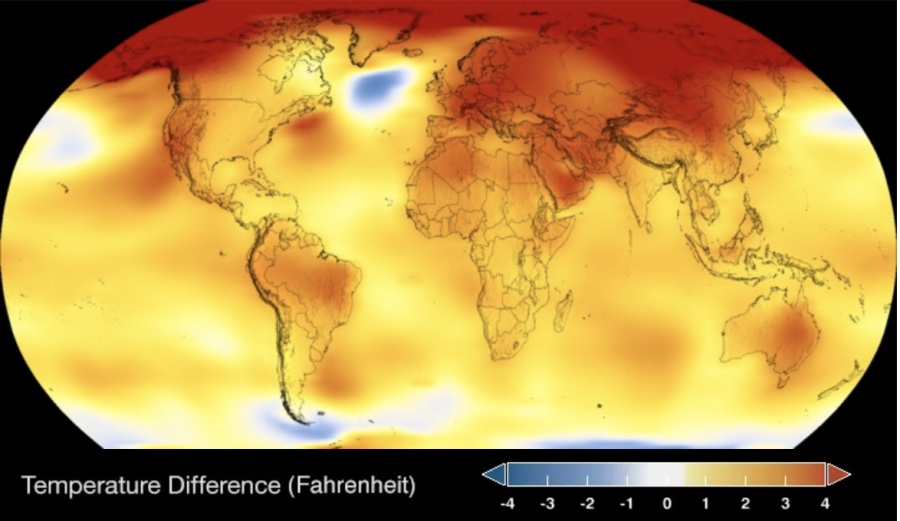Climate Change not taught in schools leading to confusion among students
The map above shows the current temperature difference across the globe. Most of the areas are either dark red, orange, or yellow. This is a sharp contrast from earlier years, which pictured mostly blue, white and some yellow spots.
Climate change is a hot button issue that has frequently been in the news cycle. However, very few people understand the science behind the warming of our planet. According to National Geographic, the Earth has gone through many cycles of climate change throughout its history. The surface has gone from boiling hot lava to ice frozen miles deep, but it is currently evident that the planet has taken a turn for the worst. Since the beginning of the industrial revolution, all the carbon dioxide and other greenhouse gases emitted have been trapped in the atmosphere- more than 200 years worth of pollution. These gases contribute to the greenhouse effect.
According to the Climate Reality Project, the greenhouse effect involves the reflection of solar radiation back into space by the Earth and its atmosphere. Some radiation is absorbed by the Earth’s surface, causing it to warm. Other infrared radiation (emitted by the Earth’s surface) is absorbed and passed in all directions by greenhouse gases in the atmosphere.
As mentioned above, solar energy is thrown back into the atmosphere as heat, or infrared radiation, causing greenhouse gases to absorb it. This is a natural process, necessary to make sure the earth is warm, but recent human activity has caused too many greenhouse gases to be released, trapping more heat in the atmosphere than normal and inevitably warming our planet.
According to NASA, the planet’s average surface temperature has risen 1.62 degrees F since the 19th century. This may not seem like a lot, but the smallest change can be the difference between life and death. This small increase has caused the oceans to rise, glaciers to melt, and ecosystems to be destroyed.
Another issue is that many students do not completely understand the processes mentioned above.
“I would say I understand the science behind climate change to a degree, but only in the sense that I know what the causes and implications are. I know that the earth is slowly heating, but I don’t know the exact science,” Junior Lucia Fernandez said.
They believe this is mainly due to schools doing a poor job educating students about climate change.
“I do not think Grady has even tried to talk about the effects of climate change. Let alone what we can do to help,” Junior Emma Menzies said. “I definitely think that climate change should be taught at Grady because it is our reality and our generation is the most affected by it.”
Fellow Junior Michelle Durst agrees.
“I haven’t been taught or spoken to about climate change since I got to Grady. The last time I was really educated about it was 6th grade with Ms. Nunnick,” Durst said. “Since we aren’t taught about it at school or anywhere, I don’t understand the specifics.”
A common misconception is that there is time to save the planet from inevitable destruction. Many people believe that we have multiple years before things will get drastic. However, multiple sources, including BBC and Forbes, say that we only have 18 months to make changes. There are actions that can be taken, but everyone, all 7.53 billion people living on this planet, need to come together to understand the problem and learn what they can do to help.
“I don’t understand what actions I can to help prevent climate change. If I knew what I could do to help, then I would jump at any opportunity to do so,” Menzies said.

Samantha enjoys soccer and violin, and is especially interested in science-related topics. She loves writing and is excited to be on Nexus.

